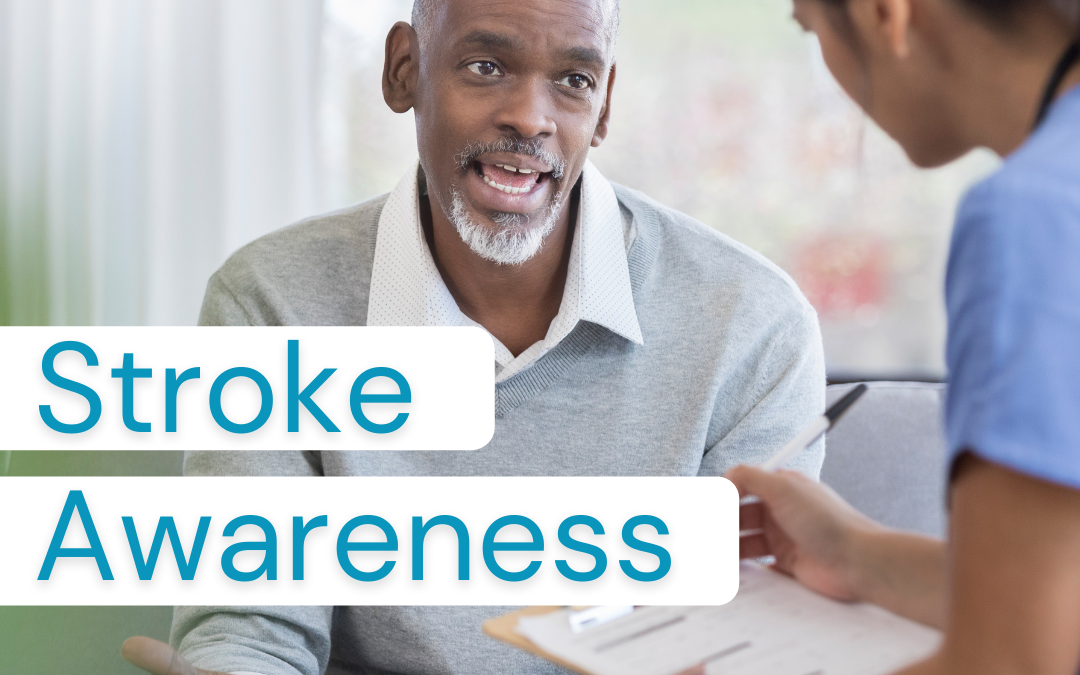Let’s get into some important stroke awareness details! Did you know that every year a person’s risk of having a stroke doubles after the age of 55?
It is important for both seniors and caregivers to be aware of this, because a stroke is a potentially fatal condition. Although a stroke is widely known to many, we want to break down the signs, symptoms and ways to prevent it. A stroke occurs when the blood flow to a portion of the brain is cut off.
Simply put, the cells in the brain that fail to receive oxygen through this blood flow will die. When those cells in the brain die, they will no longer be able to operate. The functions they were once able to perform will be completely stopped or severely damaged.
Although some risk factors of a stroke are not always preventable, there are many risk factors that are preventable. A few risk factors that cannot be controlled are age, race and gender. As we age, a person’s risk of having a stroke increases. Another factor to note is that women, as well as African Americans are most at risk of having a stroke compared to men and Caucasian individuals.
Now let’s get into risk factors that can be reduced, managed or prevented include the following:
- Individuals with circulatory diseases and blood diseases like diabetes and arterial diseases.
- Individuals that are obese
- People who have an inactive lifestyle, or make poor health choices
Signs of a Stroke (what to do if someone is having a stroke)
Now that we’ve talked about the risk factors of stroke let’s go over the signs of a stroke. Knowing the signs of a stroke and exactly what to do, can mean the difference between life and death or permanent disability for an individual. According to the American Hear Association, an easy way to remember the signs of a stroke is the acronym F-A-S-T:
- F – Face Drooping: does one side of the face droop or is it numb? You can ask the person to smile.
- A – Arm Weakness: is one arm weak or numb? Ask the person to raise both arms. Does one arm drift downward?
- S – Speech Difficulty: is speech slurred, are they unable to speak or are is it hard to understand when they speak? Ask the person to repeat a simple S sentence like “The sky is blue”. Is the sentence repeated correctly?
- T – Time to Call 9-1-1: if the person shows any of these symptoms, even if the symptoms go away, call 9-1-1 and get them to the hospital immediately.
How are Strokes Treated?
“When someone has a stroke, their doctor has to quickly diagnose and treat them in order to reduce the impact of the stroke. In most cases The medication used to treat a stroke; tissue plasminogen activator, (or Alteplase IV r-tPA) must be
administered within 3 hours of a stroke. Physical treatment to remove clots can also be performed.” Information via: https://www.stroke.org/en/about-stroke/treatment .

When someone has a stroke, recovery from a stroke is a lifelong process because brain cells have died. Depending on which part of the brain was affected from the stroke, that will determine what disability they will have. Many stroke victims lose partial use of their limbs, elements of speech or even portions of their memory. They have to undergo months and sometimes years of therapy to help them deal with their disability caused by the stroke.
Easy Steps For Stroke Prevention
Often times a stroke can be prevented through healthy lifestyle changes. Here are a few tips outlined by the CDC:
- Start making healthy foods/drinks choices
- Keep a healthy weight
- Get regular physical activity
- Quit smoke & Limit your alcohol intake
- Control your medical conditions
- Keep your cholesterol in check
- Keep your blood pressure under control (High blood pressure usually has no symptoms, be sure to have it checked on a regularly)
- Treat heart disease (take your medicine as prescribed by your doctor)
For seniors, consulting with your doctor, as well as getting assistance from family members or hiring a caregiver to help implement these lifestyle changes, can help lower your risk of a stroke. No matter your age, starting early on with healthy choices can significantly improve your quality of life and stroke risk.
If you found this information helpful, please share this blog post with a friend!



